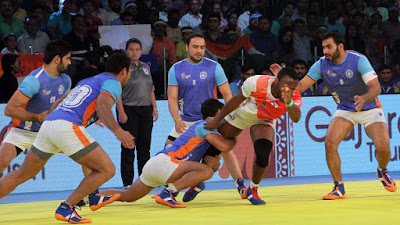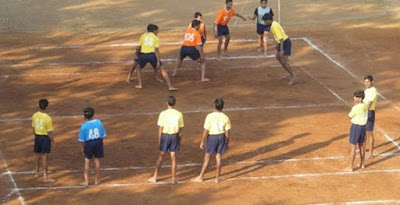KABADDI HISTORY
KABADDI WORLD CUP: 2004, 2007, 2016
 |
| Kabaddi World Cup 2016 |
About Kabaddi
Kabaddi is aptly known as the "GAME OF THE MASSES "due to its popularity, simplicity, easy to comprehend rules, and public appeal. The game calls for no sophisticated equipment what so ever, which makes it a very popular sport in the developing countries. It is basically an out door sport played on clay court, of late the game is being played on synthetic surface indoors with great success. The duration of the game is 45 minutes for MEN & Junior BOYS with a 5 minutes break in between for the teams to change sides. The duration of the game is 35 minutes with a 5 minutes break in between for WOMEN, GIRLS, Sub-Junior BOYS and Sub-Junior GIRLS.
Kabaddi is a combative team game, played on a rectangular court, either out-doors or indoors with seven players on the ground for each side. Each side takes alternate chances of offence and defense. The basic idea of the game is to score points by raiding into the opponents court and touching as many defense players as possible without getting caught on a single breath. During play, the players on the defensive side are called "Antis" while the player of the offense is called the "Raider". Kabaddi is perhaps the only combative sport in which attack is an individual attempt while defense is a group effort. The attack in Kabaddi is known as a 'Raid'. The antis touched by the raider during the attack are declared 'out' if they do not succeed in catching, the raider before he returns to home court. These players can resume play only when their side scores points against the opposite side during their raiding turn or if the remaining players succeed in catching the opponent's raider.
Yoga, the Indian science to control body and mind through meditation and self-control .plays an integral part of Kabaddi. The raider has to enter the opponent's court chanting the word "Kabaddi" while holding his breath and has to continue to do so until he returns to his home court. This is known as 'Cant', which is closely related to "Pranayama” of yoga. While Pranayama is about with holding breath in order to exercise internal organs, cant is the means to with hold breath with vigorous physical activity. This is perhaps one of the few sports to combine yoga with hectic physical activity.
The game calls for agility, good lung capacity, muscular co-ordination, presence of mind and quick responses. For a single player to take on seven opponents is no mean task, requires dare as well as an ability to concentrate and anticipate the opponent's moves.
 |
| Kabaddi |
THE GAME'S HISTORY
Kabaddi received its first Inter-National exposure during the 1936 Berlin Olympics, demonstrated by Hanuman Vyayam Prasarak Mandal, Amaravati, Maharashtra. The game was introduced in the Indian Olympic Games at Calcutta, in the year 1938. It was in 1950, that the All India Kabaddi Federation came into existence. Regular conduct of National level championships as per laid down rules and regulations began with effect from the year 1952. After the formation of the Amateur Kabaddi Federation of India, the first men's Nationals were held in Madras (now re-named Chennai), while the women's Nationals were held in Calcutta in the year 1955.
The rules were modified and some changes were introduced to the game during the National Championships held at New Delhi in the year 1954. Efforts were made to demonstrate the game in the World Youth Festival held at Moscow in the year 1957, but due to various unforeseen reasons, this could not be accomplished. The game was included in the curriculum of the Indian University Sports Control Board as a main sports discipline in the year 1961.
The game got further recognition when the School Games Federation of India included it in the school games in the year 1962. This body has taken up the responsibility of organizing state and national level competitions for school going children all over the country in various sports on a regular basis, every year.
The Amateur Kabaddi Federation of India, the new body, came into existence in the year 1972. This body was formed with a view to popularize the game in the neighboring countries and organize regular National level Men and Women tournaments. After the formation of this body, sub-junior and junior sections were included in Kabaddi national level tournaments, as a regular feature.
Kabaddi was included in the curriculum of Regular Diploma courses in coaching conducted by the National Institute of Sports, the premier institute to develop sports in the country with effect from the year 1971. There after, qualified coaches in Kabaddi are being produced every ear. The neighboring countries, Nepal & Bangladesh also send I their coaches for the diploma course in various disciplines including Kabaddi, regularly. These qualified coaches are equipped to train players at different levels in a systematic manner with sports science back up.
In the year 1974, the Indian men's team toured Bangladesh as part of the cultural exchange program to play five test matches in different parts of the country. The Bangladesh returned the visit in the year 1979 and played five test matches in India.
The Asian Amateur Kabaddi Federation was formed in the year 1978, during the silver jubilee celebrations of National Kabaddi Championships in India, organized at Bhilai, Madhya Pradesh. The first Asian Championship in Kabaddi was organized in Calcutta, in the year 1980. A goodwill tour was organized in the year 1981 in which, the Indian men & women teams visited Thailand, Japan and Malaysia to play exhibition Kabaddi matches. Federation Cup Kabaddi matches also commenced in the year 1981.
Kabaddi was included as a demonstration game in the IX Asian Games hosted by India in the year 1982. In the year 1984, an open Inter- National tournament was organized at Bombay (now renamed as Mumbai), in India. During the Tri-Centenary celebrations of the city of Calcutta, an Inter-National Invitation Kabaddi Tournament was organized in the city.
The South Asian Federation included Kabaddi as a regular sports discipline from the year 1984. Kabaddi was played for first time in the SAF games at Dacca, Bangladesh. Since then Kabaddi is being included in every SAF Games, which is played every once in two years. For the first time in the Inter-National Kabaddi scenario, India faced defeat at the hands of Pakistan and had to be satisfied with second place, winning the silver medal, in the VI SAF Games at Dacca, Bangladesh, in the year 1993.
The second Asian Championship was hosted by India and was organized at Jaipur, Rajasthan. Malaysia and Japan participated for the first time in this Championship. In the XI Asian Games held in the year 1990 at Beijing, China, Kabaddi was included in the main disciplines. This was a major landmark in the history of Kabaddi. India won the Gold Medal, which was a proud and unforgettable moment for Kabaddi lovers who had strived to bring Kabaddi to the Asian platform. India has been the reigning champion in the succeeding Asian Games held in 1994 at Hiroshima, Japan and in the Asian Games held in 1998 at Bangkok in Thailand.
An International Women Kabaddi tournament commenced in the year 1995, called the Nike Gold Cup, sponsored by NIKE, Japan. The III Asian Championship was hosted by Sri-Lanka in the year 2000. For the first time, Sri-Lanka secured a silver medal, defeating Kabaddi stalwarts Pakistan, in this Championship.
Kabaddi attained National status in the year 1918. Maharashtra was the pioneer state to bring the game to the National platform and give it further popularity. Standard rules and regulations were formulated in 1918 but were brought out in print in the year 1923 and in this very year, an All India Tournament was organized at Baroda with these rules. Kabaddi has not looked back since then and numerous tournaments are organized all over the country through out the year.
Popular Posts
PKL 2022: Pro Kabaddi League Season 9 All 12 Teams Full Squad
August 06, 2022
0 Comments